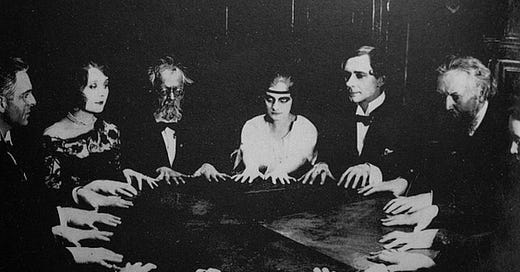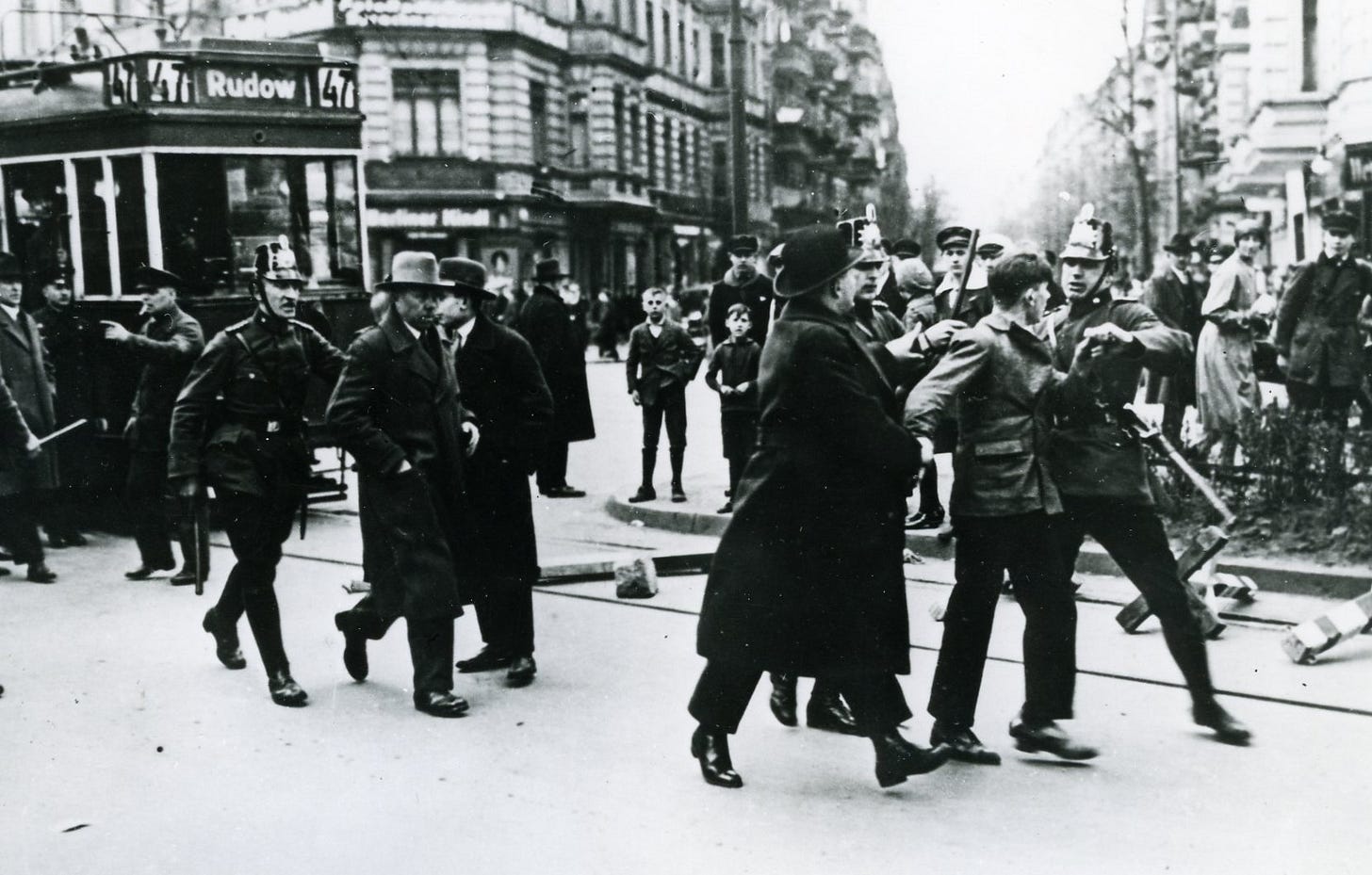Gravity's Rainbow - Part 1 - Chapter 18: Freaks in the Visitation
Analysis of Gravity's Rainbow, Part 1 - Chapter 18: The Cast of Psi-Section Characters
Carroll Eventyr was last seen in Chapter 5, acting as the medium for Roland Feldspath, a former engineer working under Captain Blicero. He finds himself a freak, having no idea why one day he stumbled upon the ability, unwillingly and through no fault of his own, to communicate with the dead — or, at least to transmit what the dead wanted to tell the living. A woman named Nora Dodson-Truck was there to witness his first communication which she could barely hear. Now, working at The White Visitation with the rest of the crew we have met, he acts as their own in-house medium, though he does not ever remember exactly what he communicates. He must read back on each communication to the other side using transcripts that other members of Psi-Section (a branch of The White Visitation that focuses on these communications) transcribe.
He too is a part of Psi-Section which is made up of many other so-called freaks who have been showing up to work at The White Visitation: Ronald Cherrycoke (descendent of another Cherrycoke in Pynchon’s Mason & Dixon) the psychometrist who — by touching possessions of the living or the dead — can read and see facts and moments of their life, Margaret Quartertone who can become what amounts to a speaker for “discs and wire recorders miles distant without speaking or physically touching the equipment” (146), and others. The White Visitation, or those who control it, like they are doing with Pirate Prentice, are utilizing these freaks to their own ends.
It’s a given that, in this agency, the “freaks” (those with special talents that can help fuel the system) will be used to some extent — but why all the new varieties? Why so many? All these freaks seem to have some connection with the other side, and the other side, “those we call the dead, are increasingly anxious and evasive” (147). It is as if the realm between the living and the dead, the Zero line, is beginning to blur. As each of us comes closer to the possibility of death, in war, for instance, we seem more able to interpret what the dead may have to say — a possible warning on the other side — because our desire to prevent this outcome removes certain blinders and reveals what the truth behind it all might mean.
But Gavin Trefoil, the youngest freak of them all, seems different. His ability is not to communicate with or interpret the “resumes” of the dead, nor is it to break barriers in ways that can only be described as magic. He has the ability to shift his skin color “from the most ghastly albino up through a smooth spectrum to very deep, purplish black” (147). Even if this seems different, his ability too balances on the edge of life and death in a number of ways. First, The White Visitation uses his ability to help create the fabricated Schwarzkommando film. His ability to become visually black has allowed their agencies to produce inexpensive propaganda which takes the fire off the white men dropping the bombs and places a wary eye on the black men who, to the current knowledge of The White Visitation, really have nothing to do with it. Secondly, the ability to change between black and white is similar to the obsession with ones and zeroes, the interplay between metaphorical (or real) life and death, as well as the infinite possibilities between these extremes.
And finally, as we see in the brief drama that plays out between skin cells, everything moves deathward. Every skin cell and melanocyte originate within the ectoderm, a layer of tissue in embryonic development in which nervous tissue and thus the CNS develops from as well. Thus, that which gave birth to what creates consciousness, our ability to move, process, and think, and for our body to perform autonomous functions of survival, also gave birth to our, and Trefoil’s, skin and skin pigmentation. Somewhere along the way — again calling to a blurring line of life and death — there must have been a mistake where the CNS still had a link to Trefoil’s melanocytes, thus allowing him to alter them at will. The skin cells (perhaps keratinocytes) may at some point have life and produce whatever color they’re meant to give off via Trefoil’s melanocytes, “But sooner or later everyone out here has to go Epidermal. No Exceptions” (148). There is no way a single one of these cells will be saved. Their purpose will be served, similar to how Trefoil is being used at the moment for his purpose, and they will eventually wither away — not a single person or thing to save them. The fearful skin cell calls to mind the opening of the novel, where at the end of the world, everything becomes clear, and now they just sit and wait, perform their duty, and die, while their overlords, the CNS, continue to produce more of them to serve the same task.
Though it may not have been obvious, this chapter so far (or most of it) has been told from the perspective of Nora Dodson-Truck, the woman who heard Eventyr as a medium for the dead and who also happens to love him despite her marriage to someone else. We see her now crossing a room in the midst of another rocket strike somewhere down the way. She is apparently using the freaks at the Psi-section in order to propagate her “ideology of the Zero” (149), or her “rejection,” though they are not being used in the sense that They are using us, it is more that they (the “freaks”) are for some reason delving into her in order to further blur these lines of life, death, or whatever similarly mapped binary structures mimic these two ideas. Their job seems to be to absorb the Zero itself, the crossing line, and Cherrycoke currently probes into Nora’s belongings, with permission, to discover those truths about her that are currently beyond the Zero and bring them to our realm.
Another instance of Psi-section’s detective work was after Basher St. Blaise’s angel. St. Blaise was a pilot in the midst of WWII who, during a raid, witnessed an angel among the clouds. His wingman and other members over his radio frequency confirmed in the sighting along with a complete mental clarity, the loss of any static over the radio, and even what sounded like singing. It is once again another blurring of the line — the witnesses of an angel are themselves the angels of death. Cherrycoke and Eventyr use their abilities to confirm the sighting.
We are reintroduced to a number of characters, the first being Peter Sachsa who was first seen as Eventyr’s control during seances (i.e. the dead medium on the other side transmitting messages and words of the dead around him to the living medium) and who we now see (in events previous to the above mentioned seance) having his own spirit being conjured by Eventyr to discuss his life before his own death with a specific focus on a seance that Sachsa had once performed. Sachsa himself was killed “by a blow from a police truncheon during a street action in Neukölln” (152). This blow likely occurred during what is now known as Blutmai, when the German Communist Party protested against sanctions by the German center-left party at the time and were thus subjected to police brutality resulting in many deaths, injuries, and the dissolution of a true German leftist party, making the likelihood of the rise of a far right-wing party far more likely — wonder who that would be.
The seance which Sachsa performed was for Lieutenant Weissmann, also known as Captain Blicero, recently returned from his adventures in Sudwest Africa with a Herero boy (the events of Blicero/Weissmann in Sudwest Africa and the Herero boy — Enzian — were more largely discussed in my analysis on the first half of Chapter 14). Now, whatever occurs at this seance — the section filled with parentheticals and ellipses — is up to you to interpret1. It appears to be a series of images and metaphors being recalled by Sachsa from the realm of the dead, especially given the translation of the Herero: “I have dreamed a nightmare . . . I saw him in my dream as if he were alive” (152). It could be the young Rauhandel, his friend from childhood, or someone else he had lost along the way.
All of these seances, visions or words of the dead, interpretations of objects owned by either living or dead, and so on, all seemingly disconnected other than the fact of their topic and the group who is exploring the phenomena, are summed up now in a brief conversation between Roger Mexico and Edwin Treacle, another member of The White Visitation who was earlier describe as a “most Freudian of psychical researchers” (92). And Edwin states that what this group is doing is important, but not necessarily special. He asks, how does one expect to understand themselves, or for a society to understand itself, without understanding the other side? Many people, “these Hereros for example — […] carry on business every day with their ancestors. The dead are as real as the living” (153). So many cultures, whether metaphorically, spiritually, literally, traditionally, etc., communicate and understand their dead. Without that, what are we, and how can we possibly begin to understand these others “without treating both sides of the wall of death with the same scientific approach” (153). So, this communication is important and natural, but the agencies controlling the Psi-Section render this action as a means to another end — to create more death.
We finally transition into the story of Leni and Franz Pökler, a couple, out of love, with a child who Leni “had not learned to escape feeling guilty for [also] not loving enough” (154). Sachsa was in love with the former, and she with him. Their stories will come next week.
If anyone has any thoughts or their own analyses on anything such as “why is Nora so central to the Psi-section,” or “what’s up with all the talking and magical body cells,” or “what does the Weissman/Sachsa seance section actually mean,” or really anything else, please let us know below!
(This here is a note from farrrrr in the future (12/07/24): after finishing Nora Dodson-Trucks final mention, I realize that her plotline and purpose eludes me. I still have no clue what to make of it. Perhaps on the next read…)
Up Next: Part 1, Chapter 19
Seriously… I have no clue what is going on here…








Can't wait for next week! Franz Pökler is possibly my favourite character in the book!
I am just now up to this chapter in my own close reading. A few thoughts:
1) the skin cell dialogue is a potent distillation of the concept of reflexive consciousness—the human condition of knowing and regarding the mystery of our mortality and what larger system may contain it. That awareness arrives with fear, wonder, an impulse to flee the reality of the condition, and a desire to understand and transcend the limits of the condition (mortality.)
2) for whatever reason, romancing Nora D-T is described as akin to trying to communicate with the other side—with the dead. I don’t know why, yet.
3) Mexico’s gruff disinterest in the other side as a clinical subject is of a piece with his character as a traditional romantic.